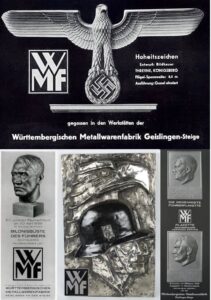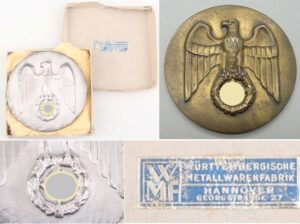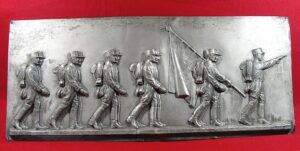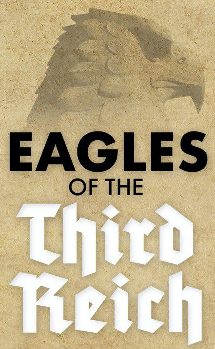WMF:
WMF was originally called Metallwarenfabrik Straub & Schweizer and was opened as a metal repairing workshop. Through mergers and acquisitions, by 1900 they were the world’s largest producer and exporter of household metalware, mainly in the Jugendstil, or Art Nouveau style, designed in the WMF Art Studio under Albert Mayer, sculptor and designer, who was director from 1884 to 1914.
WMF has been operating under the name WMF GmbH since July 1, 2012 – and no longer under WMF Group GmbH as before. Since 2016, the company has been part of the French Groupe SEB. Being a group within the group, however, has increasingly irritated both internally and externally. With the simpler name, WMF fits smoothly into the group structure while retaining its roots as a premium manufacturer within the group. The change is visible in the new corporate logo: this focuses on the WMF brand logo and visually creates a direct link to Groupe SEB. WMF also takes the new name as an opportunity to change the address at its headquarters in Geislingen. Thus, the previously known address “Eberhardstraße 35” became “WMF Platz 1”.
In 1880 after Metallwarenfabrik Straub & Schweizer merged with another German company, it was renamed as the Württembergische Metallwarenfabrik. WMF acquired the Polish metalware factory Plewkiewicz in Warsaw in 1886, which then became a subsidiary of WMF around 1900. During this period, the WMF employed over 3500 people. In 1890 they acquired the Kunstanstalt für Galvanoplastik München, which specialized in electrotyping and electroforming of statues and statuettes for buildings, fountains, tombstones, and gardens; this became the Abteilung für Galvanoplastik (Galvanoplastic Division) of WMF.[2] During the 1920s, Abteilung für Galvanoplastic was producing reproductions of large-scale Italian Renaissance bronze works for an American clientele. Albert Weiblen Marble & Granite Co., Inc. of New Orleans pursued the acquisition of a gilt copper reproduction of Ghiberti‘s “Gates of Paradise“. In 1910, the Reale Istituto di Belle Arti had granted WMF the exclusive right to take a sharp cast of the original doors, from which WMF created a reproduction that was exhibited at the International Building Trades Exhibition in Leipzig (1913).[3] WMF produced a trilingual catalog about the doors, titled Erztüre des Hauptportals am Baptisterium in Florenz.
In 1900, WMF acquired Albert Köhler’s famous Austrian metalwork company AK & CIE, who produced and distributed WMF items under their mark to the Austro-Hungarian market until about 1914. WMF purchased Orivit AG, a company known for its Jugendstil pewter in 1905, followed a year later by the purchase of the Orion Kunstgewerbliche Metallwarenfabrik, another German metalware company. WMF continued to use the goods from the acquired companies on their own markets, and conversely, they produced and distributed their objects under their acquired companies brands. One other brand they acquired was Radivon Bucarest, a company founded by medalist Theodor Radivon, producing identical art nouveau metal wares under the WMF name with the same model numbers.
During WWI, the WMF was responsible for producing arms for the German military and had certified to the Allied Control Commission that the tools used to produce these arms were destroyed. However, after Hitler’s call for rearmament the company under the control of Hugo Debach immediately began to produce arms again. Debach died shortly thereafter. Beginning in 1940 the WMF began using more and more forced labor from Soviet prisoners of war in surrounding camps, these people eventually made up 1/3 of the firm’s labor force. WMF also founded their own concentration camp in 1944 to detain and force over 900 Hungarian Jewish women to work for them.





